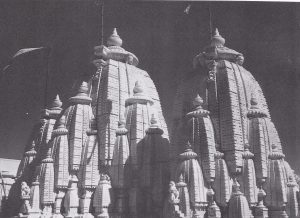Shankeshvara
 Parshvanatha Shankesvara Temple. Part view,
Parshvanatha Shankesvara Temple. Part view,
Shankeshvara (see map ill. 270) is a historic Jaina site comprising an old temple within a fortified enclosure, some new to very new temples, about a dozen dharmashalas, a bus stand, and one long street lined with shops. Usually called Parshvanath Shankeshvar, it is the most popular place of pilgrimage next to Palitana in Gujarat. It is the marble image of a seated Parshvanatha in the sanctum of the old temple that the pilgrims desire to see. Worshipping this statue in the proper frame of mind is believed to dissipate one’s miseries.
Little is known about the early history of this locality as a holy Jaina tirtha Popular belief dates the beginning back to Shri Krishna’s time, when, it is thought, a layman named Ashadhi installed Jima idols in three places named in old records as Charoopa, Stambhapura and Shankesvara.
In 1098, during the time of the Patan king Jayasimaha (mentioned above, p. 190), the state’s minister-in-chief had the fort and the temple repaired. Early in the fourteenth century. Shankeshvara, like many other places in Western India, was raided and badly damaged by soldiers of the Delhi Sultan Alau-u’d-Din Khilji, but the statue of Parshvanatha was rescued and kept hidden. Rebuilding began in the seventeenth century under the Mughal emperors.
